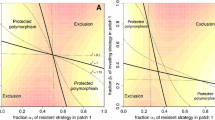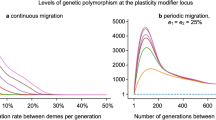Summary
The adaptation to a variable environment has been studied within soft and hard selection frameworks. It is shown that an epistatically determined habitat preference, following a Markovian process, always leads to the maintenance of an adaptive polymorphism, in a soft selection context. Although local mating does not alter the conditions for polymorphism maintenance, it is shown that, in that case, habitat selection also leads to the evolution of isolated reproductive units within each available habitat. Habitat selection, however, cannot evolve in the total absence of adaptive polymorphism. This represents a theoretical problem for all models assuming habitat selection to be an initially fixed trait, and means that within a soft selection framework, all the available habitats will be exploited, even the less favourable ones.
On the other hand, polymorphism cannot be maintained when selection is hard, even when all individuals select their habitat. Here, the evolution of habitat selection does not need any prerequisite polymorphism, and always leads to the exploitation of only one habitat by the most specialized genotype. It appears then that hard selection can account for the existence of empty habitat and for an easier evolution of habitat specialization.
Similar content being viewed by others
References
Anderson, S. S., McRea, K. D., Abrahamson, W. G. and Hartzel, L. M. (1989) Host genotype choice by the ball gallmakerEurosta solidaginis (Diptera Tephritidae).Ecology 70, 1048–54.
Anstensrud, M. and Schram, T. A. (1988) Host and site selection by the larval stages and adults of the parasitic copepodLernaeenicus sprattae (Sowerby)(Copepoda, Pennellidae) in the Oslofjord.Hydrobiologia 167/168, 587–95.
Barton, N. and Clark, A. (1990) Population structure and processes in evolution.Population Biology: Ecological and Evolutionary Viewpoints (K. Wöhrmann and S. K. Jain, eds), pp. 115–73. Springer-Verlag, Berlin, Germany.
Bush, G. L. (1975) Sympatric speciation in phytophagous parasitic insects.Evolutionary Strategies of Parasitic Insects and Mites (P. W. Price, ed.), pp. 187–204. Plenum, New York, USA.
Cavener, D. (1979) Preference for ethanol inDrosophila melanogaster associated with the alcohol deshydrogenase polymorphism.Behavior. Genet. 9, 359–65.
Christensen, B. (1977) Habitat preference among amylase genotypes inAsellus aquaticus (Isopoda, Crustacea.Hereditas 87, 21–6.
De Meeûs, T., Renaud, F. and Gabrion, C. (1990) A model for studying isolation mechanisms in parasite populations: the genusLepeophtheirus (Copepoda, Caligidae).J. Exp. Zool. 254, 207–14.
Dempster, E. R. (1955) Maintenance of genetic heterogeneity.Cold Spring Harb. Symp. Quant. Biol. Sci. 20, 25–32.
Diehl, S. R. and Bush, G. L. (1989) The role of habitat preference in adaptation and speciation.Speciation and its consequences (D. Otte and J. A. Endler, eds) pp. 345–85. Sinauer Associates, Sunderland, MA, USA.
Doyle, R. W. (1975) Settlement of planktonic larvae: a theory of habitat selection in varying environments.Am. Nat. 109, 113–26.
Emson, R. H. and Mladenov, P. V. (1987) Brittlestar host specificity and apparent host discrimination by the parasitic copepodOphiopsyllus reductus.Parasitology 94, 7–15.
Eyland, E. A. (1971) Moran's island migration model.Genetics 69, 399–403.
Felsenstein, J. (1981) Skepticism towards Santa Rosalia, or why are there so few kinds of animals?Evolution 35, 124–38.
Fox, L. R. and Morrow, P. A. (1981) Specialization: species property or local phenomenon?Science 211, 887–93.
Futuyma, D. J. and Mayer, G. C. (1980) Non-allopatric speciation in animals.Syst. Zool. 29, 254–71.
Futuyma, D. J. and Moreno, G. (1988) The evolution of ecological specialization.Ann. Rev. Ecol. Syst. 19, 207–33.
Garcia-Dorado, A. (1986) The effect of niche preference on polymorphism protection in a heterogeneous environment.Evolution 40, 936–45.
Garcia-Dorado, A. (1987) Polymorphism from environmental heterogeneity: some features of genetically induced niche preference.Theor. Pop. Biol. 32, 66–75.
Gibbons, J. R. H. (1979) A model for sympatric speciation inMegarhyssa (Hymenoptera, Ichneumonidae): competitive speciation.Am. Nat. 114, 719–41.
Gliddon, C. and Strobeck, C. (1975) Necessary and sufficient conditions for multiniche polymorphism in haploids.Am. Nat. 109, 233–5.
Hedrick, P. W. (1986) Genetic polymorphism in heterogeneous environment: a decade later.Ann. Rev. Ecol. Syst. 17, 535–66.
Hedrick, P. W. (1990a) Genotypic habitat selection: a new model and its application.Heredity 65, 145–9.
Hedrick, P. W. (1990b) Theoretical analysis of habitat selection and the maintenance of genetic variation.Ecological and Evolutionary Genetics of Drosophila (J. S. F. Baeker, W. T. Starmer and R. J. McIntyre, eds), pp. 209–27. Plenum, New York, USA.
Hoekstra, R. F., Bijlsma, R. and Dolman, A. J. (1985) Polymorphism from environmental heterogeneity: models are only robust if the heterozygote to the favoured homozygote in each environment.Genet. Res. Cambr. 45, 299–314.
Kjellberg, G., Gouyon, P. H., Ibrahim, M., Raymond, M. and Valdeyron, G. (1987) The stability of the symbiosis between dioecious figs and their pollinators: a study ofFicus carica L. andBlastophaga psenes L.Evolution 41, 693–704.
Jones, J. S. and Probert, R. F. (1980) Habitat selection maintains a deleterious allele in a heterogeneous environment.Nature 287, 632–3.
Levene, H. (1953) Genetic equilibrium when more than one ecological niche is available.Am. Nat. 87, 331–3.
Maynard-Smith, J. (1962) Disruptive selection, polymorphism and sympatric speciation.Nature 195, 60–2.
Maynard-Smith, J. (1966) Sympatric speciation.Am. Nat. 100, 637–49.
Maynard-Smith, J. (1970) Genetic polymorphism in a varied environment.Am. Nat. 104, 487–90.
Maynard-Smith, J. and Hoekstra, R. F. (1980) Polymorphism in a varied environment: how robust are the models?Genet. Res. Camb. 35, 45–57.
Mayr, E. (1963)Populations, Species and Evolution. Harvard University Press, Cambridge, MA, USA.
Mayr, E. (1982) Speciation and macroevolution.Evolution 36, 1119–32.
Moran, P. A. P. (1959) The theory of some population genetics effects of population subdivision.Aust. J. Biol. Sci. 12, 109–16.
Myers, J. H., Monro, J. and Neil, M. (1981) Egg clumping, host plant selection and population regulation inCactoblastis cactorum (Lepidoptera).Oecologia 51, 7–13.
Olson, R. O. (1985) The consequences of short-distance larval dispersal in a sessile marine invertebrate.Ecology 66, 30–9.
Prout, T. (1968) Sufficient conditions for multiple niche polymorphism.Am. Nat. 102, 493–6.
Rausher, M. D. (1984) The evolution of habitat preference in subdivided populations.Evolution 38, 596–608.
Rhode, K. (1979) A critical evaluation of intrinsic and extrinsic factors responsible for niche restriction in parasites.Am. Nat. 114, 648–71.
Rice, W. R. (1984) Disruptive selection on habitat preference and the evolution of reproductive isolation: a simulation study.Evolution 38, 1251–60.
Rice, W. R. (1987) Speciation via habitat specialization: the evolution of reproductive isolation as a correlated character.Evol. Ecol. 1, 301–14.
Rice, W. R. and Salt, G. W. (1988) Speciation via disruptive selection: experimental evidence.Am. Nat. 131, 911–17.
Rosenzweig, M. L. (1978) Competitive speciation.Biol. J. Linn. Soc. 10, 275–89.
Rosenzweig, M. L. (1987) Habitat selection as a source of biological diversity.Evol. Ecol. 1, 315–30.
Rosenzweig, M. L. and McCord, R. D. (1991) Incumbent replacement — evidence for long term evolutionary progress.Paleobiology 17, 202–13.
Rosenzweig, M. L. and Taylor, J. A. (1980) Speciation diversity in Ordovician invertebrates: filing niches quickly and carefully.Oikos 35, 236–43.
Smiley, J. (1978) Plant chemistry and the evolution of specificity: new evidence fromHeliconius andPassiflora.Science 201, 745–7.
Strobeck, C. (1974) Sufficient conditions for polymorphism with N niches and M mating groups.Am. Nat. 108, 152–6.
Tauber, C. A. and Tauber, M. J. (1977) A genetic model for sympatric speciation through habitat diversification and seasonal isolation.Nature 268, 702–5.
Tauber, C. A. and Tauber, M. J. (1989) Sympatric speciation in insects: perception and perspective.Speciation and Its Consequences (D. Otte and J. A. Endler, eds), pp. 307–44. Sinauer Associates, Sunderland, MA, USA.
Templeton, A. R. and Rothman, E. D. (1981) Evolution in fine grained environments. II. Habitat selection as a homeostatic mechanism.Theor. Popul. Biol. 19, 326–40.
Thoday, J. M. and Gibson, J. B. (1970) The probability of isolation by disruptive selection.Am. Nat. 104, 219–30.
Wallace, B. (1968) Polymorphism, population size, and genetic load,Population Biology and Evolution (R. C. Lewontin, ed.), pp. 87–108. Syracuse University Press, Syracuse, NY, USA.
Wallace, B. (1975) Hard and soft selection revisited.Evolution 29, 465–73.
Wasserman, S. S. and Futuyma, D. J. (1981) Evolution of host plant utilisation in laboratory populations of the southern cowpea weevil,Callosobruchus maculatus Fabricius (Coleoptera, Bruchidae).Evolution 35, 605–17.
Wilson, D. S. and Turelli, M. (1986) Stable underdominance and the evolutionary invasion of empty niches.Am. Nat. 127, 835–50.
Wood, T. K. and Guttman, S. I. (1983)Euchenopa binotata complex: sympatric speciation?Science 220, 310–12.
Author information
Authors and Affiliations
Rights and permissions
About this article
Cite this article
de Meeûs, T., Michalakis, Y., Renaud, F. et al. Polymorphism in heterogeneous environments, evolution of habitat selection and sympatric speciation: Soft and hard selection models. Evol Ecol 7, 175–198 (1993). https://doi.org/10.1007/BF01239387
Issue Date:
DOI: https://doi.org/10.1007/BF01239387




